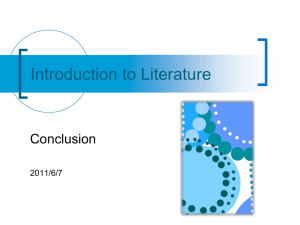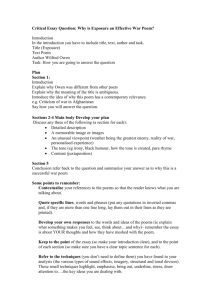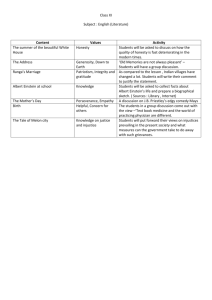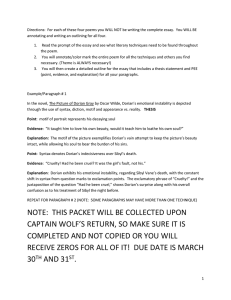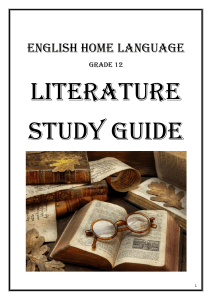Study Guide for AP Literature and Composition Midterm
advertisement
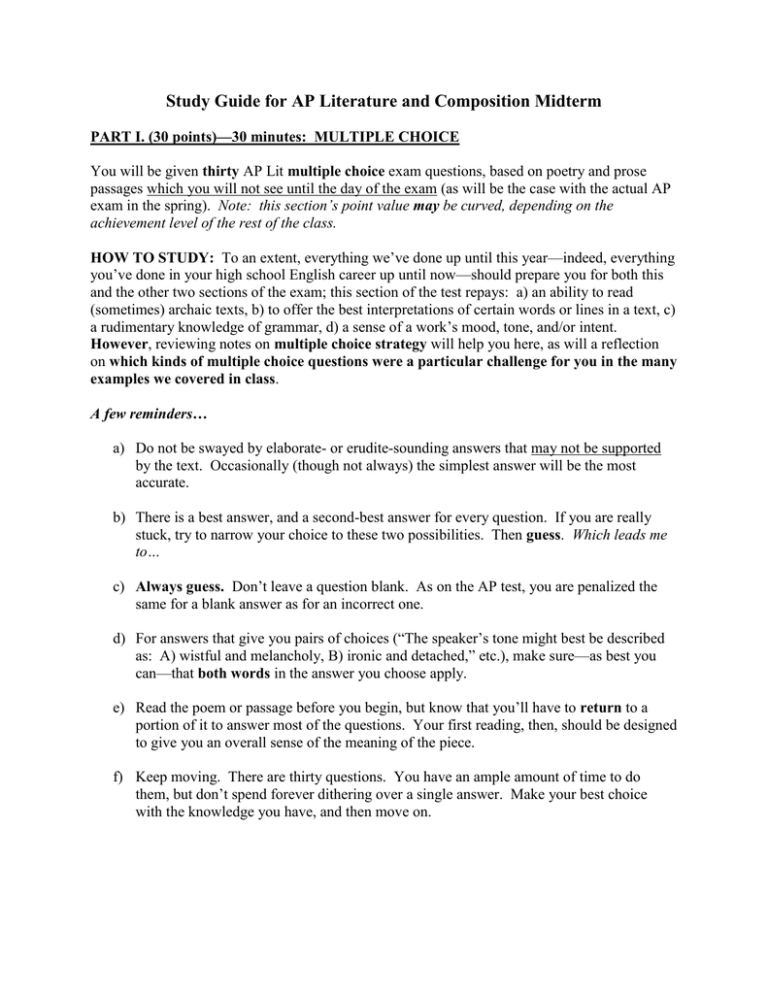
Study Guide for AP Literature and Composition Midterm PART I. (30 points)—30 minutes: MULTIPLE CHOICE You will be given thirty AP Lit multiple choice exam questions, based on poetry and prose passages which you will not see until the day of the exam (as will be the case with the actual AP exam in the spring). Note: this section’s point value may be curved, depending on the achievement level of the rest of the class. HOW TO STUDY: To an extent, everything we’ve done up until this year—indeed, everything you’ve done in your high school English career up until now—should prepare you for both this and the other two sections of the exam; this section of the test repays: a) an ability to read (sometimes) archaic texts, b) to offer the best interpretations of certain words or lines in a text, c) a rudimentary knowledge of grammar, d) a sense of a work’s mood, tone, and/or intent. However, reviewing notes on multiple choice strategy will help you here, as will a reflection on which kinds of multiple choice questions were a particular challenge for you in the many examples we covered in class. A few reminders… a) Do not be swayed by elaborate- or erudite-sounding answers that may not be supported by the text. Occasionally (though not always) the simplest answer will be the most accurate. b) There is a best answer, and a second-best answer for every question. If you are really stuck, try to narrow your choice to these two possibilities. Then guess. Which leads me to… c) Always guess. Don’t leave a question blank. As on the AP test, you are penalized the same for a blank answer as for an incorrect one. d) For answers that give you pairs of choices (“The speaker’s tone might best be described as: A) wistful and melancholy, B) ironic and detached,” etc.), make sure—as best you can—that both words in the answer you choose apply. e) Read the poem or passage before you begin, but know that you’ll have to return to a portion of it to answer most of the questions. Your first reading, then, should be designed to give you an overall sense of the meaning of the piece. f) Keep moving. There are thirty questions. You have an ample amount of time to do them, but don’t spend forever dithering over a single answer. Make your best choice with the knowledge you have, and then move on. PART II. (50 points)—40 minutes: POETRY ESSAY QUESTION You will be given an AP-style essay question on a poem that you will not see until the day of the exam. Your response will be in the form of a multi-paragraph essay (of the type we have frequently done in class). HOW TO STUDY: Ditto the last set of instructions: to an extent, the semester in AP Lit—and the comments I have made on your work—should help you to answer this question. If you are particularly concerned about it, it may be helpful to review my notes on both the prose and poetry prompts we have done in class (you have access to your portfolios at all times). A few reminders… a) An introduction of about three or four sentences is appropriate. Be sure to create a precise and focused thesis statement where you (do not merely restate the prompt). b) My suggestion has been that you eschew a conclusion. If you feel that you have time for one, it should not simply repeat points you’ve already made. c) Embedded quotations from the text (remember to delineate line breaks with a / ) are a must. d) Your organization should be chronological (though you should give yourself permission to tie together passages that might occur at different points in the poem if you are trying to make a particular argument with them). The paragraphs need not have topic sentences, but they should cohere around a main claim, and the decision to move on to a new paragraph should have some kind of rhyme or reason. e) Precision is king. You should use specific, nuanced language to reflect the reality of the poem. But however specifically you write about particular moments in the poem, don’t miss the forest for the trees. Your reader should have the sense that you have a sense of the overall “story” of the poem. f) Spend more time thinking and analyzing the ENTIRE text rather than paraphrasing the text in your response. Many writers miss or ignore subtle shades of meaning which show contrasts or similarities. Look for ambiguities and ambivalence in the selection. g) Good mechanical writing is valued on the AP test, as it is here. It would be a good idea, if you have any nagging punctuation/usage/grammar/spelling problems, to address these prior to the exam. See me if you need help. PART III. (50 point)—40 minutes: OPEN ESSAY QUESTION You will be given an AP-style open question (traditionally, Question #3 on the actual AP test), and you will be asked to base this question on one of the complete works we have studied this year so far: Hamlet, Rosencrantz and Guildenstern Are Dead, Dorian Gray, or The Sun Also Rises. Depending on the question I choose, you may have a choice between two works, or you may be confined to only one of them. HOW TO STUDY: Review your notes from class, so that you have, in your memories, the general plot outline, the major themes, and the major characters from each text. Note: I would suggest memorizing (because I will not feed you these names): Hamlet, Claudius, Gertrude, Polonius, Ophelia, Laertes, Rosencrantz, Guildenstern, The Player, Alfred, Dorian Gray, Lord Henry, Basil Hallward, Sybil Vane, Jake Barnes, Robert Cohn, Lady Brett Ashley, Mike, Bill, and Pedro Romero. Be careful if you use Sparknotes to review. If you use it, use it judiciously. It can help with a review of the general plot and the names of characters. However, it is very easy to “absorb” (even without meaning to) analyses of characters and themes from that website and to find your suddenly “regurgitating” them as your own. Be very wary of this. I will expect your own original thoughts on this essay. Review notes from the day I introduced the open question. A few reminders… a) What I wrote above for introductions and conclusions goes for this question, too. b) You will most likely not use any quotations (you will not have the text in front of you). If you feel as if you remember an important phrase or line word-for-word, then you can quote it. But it’s not necessary, and you definitely shouldn’t quote a half-remembered bit of text. c) One of the biggest stumbling blocks of this question—both historically, and for your section of students this year—has been a failure to answer the question, either wholly or partially. Though it sounds obvious, make sure to answer the question—and to do it in your intro. d) Precision is still king, even without the text in front of you. Complex, nuanced arguments are much better than vague, superficial ones. Take a moment or two to think before you begin writing. e) At the same time, don’t make the question harder than it has to be. If you are asked to select a certain kind of character, and you are caught between a more obvious and a harder-to-argue choice, go for the more obvious one. You won’t be rewarded for challenging yourself with your topic. Instead, it will be the way you approach that topic that will be key. PLEASE BRING BOTH PEN AND PENCIL TO THE EXAM. AND REMEMBER… “The readiness is all…” —Hamlet (V.ii)
